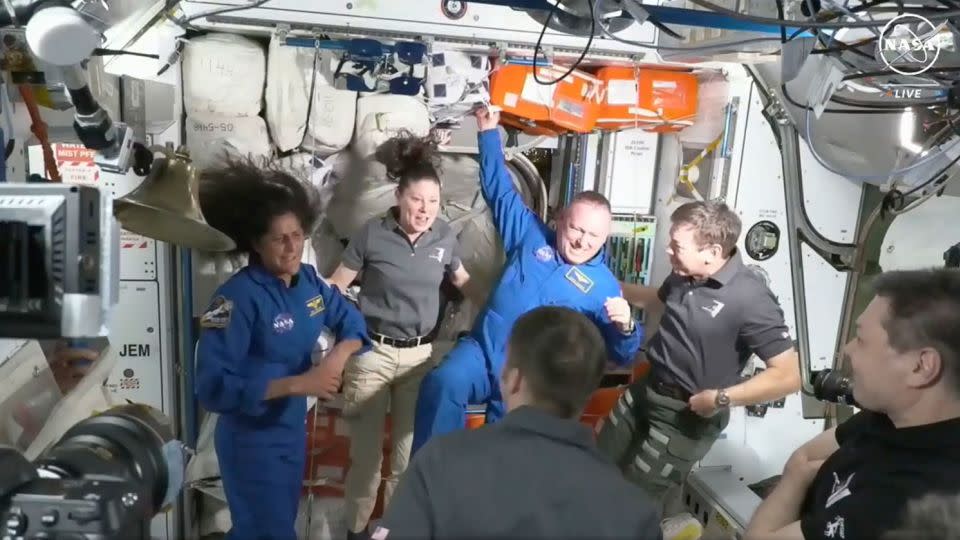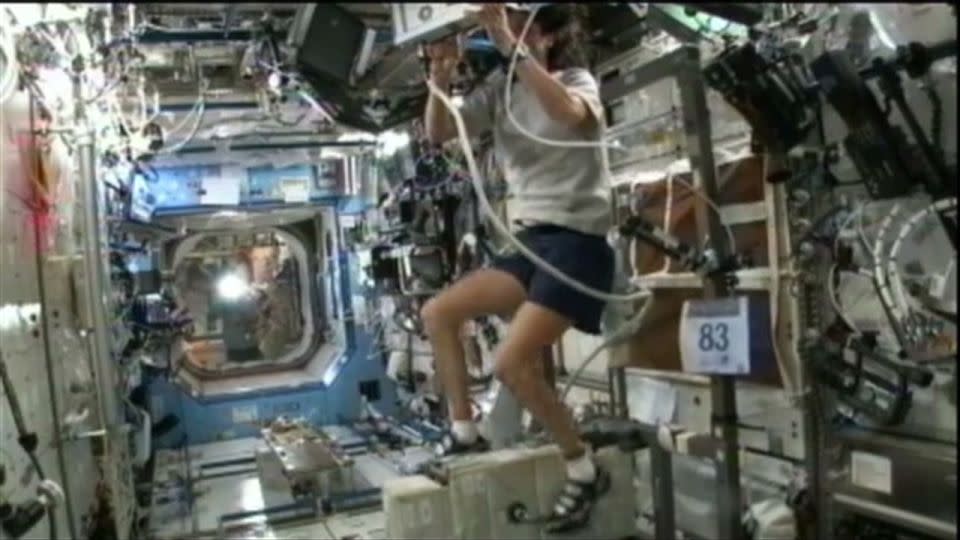[ad_1]
Subscribe to CNN's Wonder Theory newsletter. Explore the universe with news about amazing discoveries, scientific advances, and more..
When astronauts Suni Williams and Butch Wilmore left Earth for the International Space Station nearly three months ago, they ditched their bags for a crucial piece of equipment. On the first crewed test flight of Boeing’s Starliner spacecraft, they left without their personal items and other amenities—hoping to return to Earth in a week or so.
They have now spent more than 11 weeks on the space station, however, NASA It was announced on Saturday. They will remain there until early 2025. Uncertainty over problems with the Starliner capsule prompted the space agency to enlist SpaceX to step in and fly the astronauts back aboard the Crew Dragon capsule instead.
So what exactly will Williams and Wilmore be doing for another five or six months in space?
Currently, the two are guests. They are not part of Expedition 71, International crew They are among seven astronauts serving as the official crew of the space station. However, NASA said they have integrated seamlessly into the group, taking on daily duties aboard the orbiting laboratory.
But now Williams and Wilmore are expected to become full-time crew members — joining SpaceX's Crew-9 astronauts, who are scheduled to launch on their mission on Sept. 24.
As part of Crew 9 and the official expedition, Williams and Wilmore will perform typical crew duties, such as conducting spacewalks outside the space station, maintaining the orbiting laboratory and executing a tight schedule of science experiments.
NASA previously confirmed that Starliner astronauts are ready to make such a transition.
“Two years ago, we made a decision — knowing that this was a test flight — to make sure that we had the resources, the supplies and the training for the crew, just in case they needed to stay on the International Space Station, for whatever reason, for a longer period of time,” Dana Weigel, NASA’s International Space Station program manager, said during an Aug. 7 briefing.
“Butch and Sonny are fully trained, capable of doing spacewalks, robotics, whatever we need them to do,” Weigel added.
Join Crew 9
SpaceX's Crew-9 mission is a routine replenishment mission to the International Space Station, which was originally scheduled to carry four astronauts.
But under NASA's new plan, two astronauts won't be able to make the trip. Instead, the Crew Dragon spacecraft will launch with just two people on board.


The ballast, or pieces of metal that act as dead weight, will fly alongside the two empty seats on the Crew 9 spacecraft to maintain the Crew Dragon spacecraft's center of gravity, the space agency said during a news conference in early August to explain the contingency plan.
The two Crew 9 astronauts will then join Williams and Wilmore aboard the space station, and the four will complete the Expedition 72 crew, which will also include Russian cosmonauts and is expected to begin in September after the delivery period.
As is customary for routine missions to the space station, the Crew 9 astronauts will remain aboard the station for about five or six months — leaving Williams and Wilmore in space for another half a year in addition to the roughly three months they have already spent in space.
Once they become part of Crew 9, they will fall into a structured routine, with their days mostly planned hour by hour.
Olympic Games in Orbit
Indeed, astronauts have been involved in some of these daily tasks. Recent updates from NASA say Williams and Wilmore have spent their time so far maintaining the space station, checking out hardware, organizing cargo, performing Starliner checks, and assisting with science experiments and technical demonstrations.
on FridayFor example, Wilmore helped create a new air chamber, built by U.S.-based NanoRacks, that will serve as a new gateway to help deploy satellites, experiments and other equipment.
However, Williams and Wilmore also had opportunities to have some fun in zero gravity. NASA shared footage On July 26, astronauts passed a plastic torch aboard the International Space Station and mimicked Olympic events, including the discus throw and pommel horse. (Exercise is essential for astronauts to avoid losing too much muscle and bone density while in space.)
It is worth noting that Williams has already proven her abilities as an outstanding space athlete.
In 2012, during a previous trip to the International Space Station, she became the first person to complete a triathlon in space. Williams used a stationary bike, simulated swimming with a weightlifting machine, and ran on a treadmill while strapped into a harness so she wouldn't float away.


She achieved this feat after running the Boston Marathon from the International Space Station in 2007.
Williams and Wilmore logged a combined 500 days in space before launching on the Starliner test flight. Williams even said she cried after leaving the space station after her final mission in 2012, unsure if she would ever return.
“This flight is a dream for her,” a NASA commentator said during a livestream of the Starliner on June 5. Launches.
Extended stays in space
It is not uncommon for astronauts to suddenly encounter Extend their stay On board the space station – for days, weeks or even months.
For example, NASA astronaut Frank Rubio was scheduled to spend about six months aboard the International Space Station on his inaugural flight to low Earth orbit that began in September 2022. Instead, he spent 371 days in space after a coolant leak was discovered coming from his original flight — a Russian Soyuz capsule. During docking with the International Space Station.
Rubio's year-long stay ended with him setting an American record for the most consecutive days spent in orbit.
Astronauts also routinely extend their stay at the station by several days or weeks at a time due to a variety of factors, including bad weather on Earth or other schedule adjustments.
Without bag
Traveling to the space station without their carry-on bags may have complicated the Starliner astronauts' comfort during their long stay. NASA opted to remove their luggage from the spacecraft to make room for a much-needed pump to fix a broken toilet on the space station.
The astronauts may finally have a temporary reprieve after a Northrop Grumman resupply mission arrived at the International Space Station earlier this month.
“We like to keep our options open, so we have some items like clothing… some personal food items for (Williams and Wilmore), things like that,” He said Bill Speich, NASA's Operations Integration Manager for the International Space Station Program, during a press conference.
There is no indication that food supplies are running low anytime soon. Supplies have been loaded onto a Northrop Grumman ship. 8200 lbs The ship's cargo of scientific experiments and goods was food, including meals and produce such as squash, radishes, carrots, blueberries, oranges, apples and coffee, according to Speich.
Weigel also said Saturday that the space agency tends to keep four months’ worth of food and water on the space station. The Northrop Grumman resupply flight helped replenish those reserves, leaving plenty of extra food on board for the ISS crew.
“No one had to go on a diet or restrict calories,” Weigel said.
However, NASA said it needed to make a quick decision on how to get Williams and Wilmore back to Irish, because the space station's supply of food and other resources is not unlimited.
“While they’re up there, we have extra crew, we have extra hands, and they can do a lot of work,” Ken Bowersox, associate administrator for NASA’s Space Operations Directorate, said earlier this month. “But they’re also using more consumables and more supplies.”
“We need to get these people home and back to the normal crew size on the International Space Station,” Bowersox added.
For more CNN news and newsletters, create an account at CNN.com
[ad_2]
Source